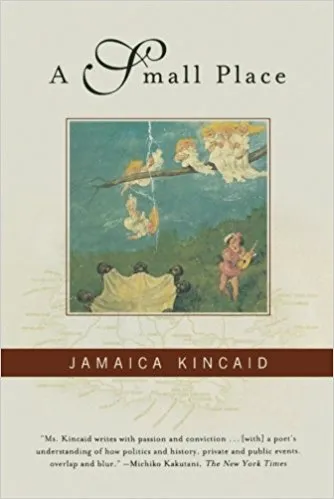
Why Reading Multicultural Literature is Important
This content contains affiliate links. When you buy through these links, we may earn an affiliate commission.
 I sat at the kitchen table in my grandmother’s house in Florida, flipping through the pages of Jamaica Kincaid’s book A Small Place. I had a week to finish the book and write a ten-page paper for my Multicultural Literature class on the effects of colonialism and tourism that Kincaid describes in the book. My cousin sat across from me and my mother was behind me washing dishes. I explained how, in the book, Kincaid criticizes tourism as a neo-colonial structure. How every year, tourists visit Antigua and countless other countries and only see one side of the people and the culture. My cousin looked up and said, “Well, if they don’t want us visiting their country, then we can take our money someplace else.”
The comment shocked me; how could someone be so insensitive to the experiences of others? Now, my cousin is white, like your All-American boy white, and grew up in a pretty white neighborhood. I am biracial, and grew up in a diverse city outside of The Bronx. And our experiences and perception of the world could not be further from each other. But this isn’t a story about my childhood. I often think back to that day and wonder if his opinion would be different if schools put more multicultural literature in their reading curriculum.
Before I started writing professionally, I was a high school English teacher, reading and teaching the same books I read while in high school. Books written by old white men (with some white women thrown in). Of course, when the time came, there were days when we talked about Langston Hughes, Zora Neal Hurston, and Lorraine Hansberry: the typical black authors that kids learn about in school. But it was rare that I was able to find books written by Latinx, Asian, African, or Middle Eastern authors in my school’s book room.
Students of color are expected to know and learn all about the white experience and hear white stories. However, the same is not expected for white students when it comes to knowing our perspective. It’s not rare that students of color often feel underrepresented. Countless students asked why we couldn’t read more books and stories by ethnic authors. Teaching one side of a narrative is unrealistic. Sometimes I think that because our stories and viewpoints aren’t being told is why many white people have problems understanding our perspectives on things.
If you are an English major, it is a requirement that you take a few classes on ethnic literature. But even then, it’s not perfect. The perspective of African, Asian, Native and Hispanic American authors are separate from an American Literature class. Why? They are, after all, American, right? Why, for lack of better words, segregate these authors from the American Literature narrative? Our stories are just as important as Fitzgerald’s, Hemingway’s, Whitman’s, etc.
America isn’t the only country that seems to have this problem; The United Kingdom is another nation that favors the stories of white authors over ethnic Brits. University student, Mariya Hussain speaks about this very same issue in her article, “Why is My Curriculum White?” She digs deeper into the university curriculum in general, not just in literature. Eurocentric, white narrative is favorable throughout a curriculum.
The American school system should focus more on what they could do to have an inclusive reading list. Classrooms across the country have students of different races, ethnicities, religions, and sexualities that deserve to have their stories told.
I sat at the kitchen table in my grandmother’s house in Florida, flipping through the pages of Jamaica Kincaid’s book A Small Place. I had a week to finish the book and write a ten-page paper for my Multicultural Literature class on the effects of colonialism and tourism that Kincaid describes in the book. My cousin sat across from me and my mother was behind me washing dishes. I explained how, in the book, Kincaid criticizes tourism as a neo-colonial structure. How every year, tourists visit Antigua and countless other countries and only see one side of the people and the culture. My cousin looked up and said, “Well, if they don’t want us visiting their country, then we can take our money someplace else.”
The comment shocked me; how could someone be so insensitive to the experiences of others? Now, my cousin is white, like your All-American boy white, and grew up in a pretty white neighborhood. I am biracial, and grew up in a diverse city outside of The Bronx. And our experiences and perception of the world could not be further from each other. But this isn’t a story about my childhood. I often think back to that day and wonder if his opinion would be different if schools put more multicultural literature in their reading curriculum.
Before I started writing professionally, I was a high school English teacher, reading and teaching the same books I read while in high school. Books written by old white men (with some white women thrown in). Of course, when the time came, there were days when we talked about Langston Hughes, Zora Neal Hurston, and Lorraine Hansberry: the typical black authors that kids learn about in school. But it was rare that I was able to find books written by Latinx, Asian, African, or Middle Eastern authors in my school’s book room.
Students of color are expected to know and learn all about the white experience and hear white stories. However, the same is not expected for white students when it comes to knowing our perspective. It’s not rare that students of color often feel underrepresented. Countless students asked why we couldn’t read more books and stories by ethnic authors. Teaching one side of a narrative is unrealistic. Sometimes I think that because our stories and viewpoints aren’t being told is why many white people have problems understanding our perspectives on things.
If you are an English major, it is a requirement that you take a few classes on ethnic literature. But even then, it’s not perfect. The perspective of African, Asian, Native and Hispanic American authors are separate from an American Literature class. Why? They are, after all, American, right? Why, for lack of better words, segregate these authors from the American Literature narrative? Our stories are just as important as Fitzgerald’s, Hemingway’s, Whitman’s, etc.
America isn’t the only country that seems to have this problem; The United Kingdom is another nation that favors the stories of white authors over ethnic Brits. University student, Mariya Hussain speaks about this very same issue in her article, “Why is My Curriculum White?” She digs deeper into the university curriculum in general, not just in literature. Eurocentric, white narrative is favorable throughout a curriculum.
The American school system should focus more on what they could do to have an inclusive reading list. Classrooms across the country have students of different races, ethnicities, religions, and sexualities that deserve to have their stories told.











